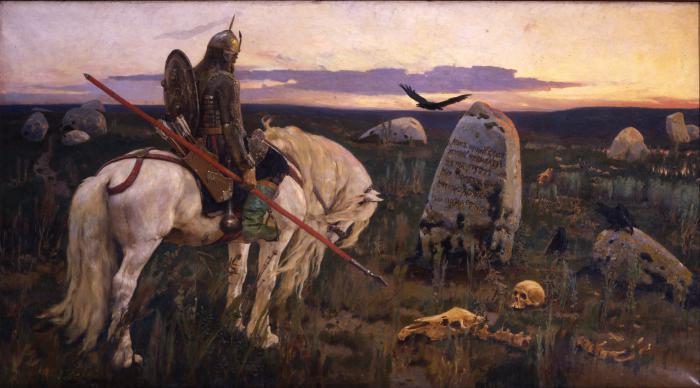Description of the painting "The Knight at the Crossroads". History of its creation
Vasnetsov's paintings are known to everyone, but fewknows that their creation was the result of a complex internal struggle of the author. The commonwealth of the Peredvizhniki artists, to which he belonged, propagated the sharply social orientation of the plots for genre paintings. Vasnetsov was wholly possessed by a fantastic theme. It was necessary to decide in which direction to move on. These experiences in many respects resulted in the picture "The Knight at the Crossroads".
An innovative genre in creating paintings
It should be noted that having chosen the path of the storyteller, Vasnetsov was an innovator in this field. It is hardly possible to name the name of another painter, who devoted himself so selflessly to the Russian epic past.

The description of the picture "The Knight at the Crossroads" followsbegin with a story about a small pencil sketch made by the master in the early seventies. Then his fantasy was captured by the story of the Russian epic about Ilya Muromets and robbers. Later this theme was developed by the author in several watercolors and oil paintings.
The first finished canvas appeared in 1877and was called "The Warrior in a helmet with a chain mail." It is curious that for the figure of the warrior the artist's brother Arkady posed. Gradually, with each new work, the composition of the picture begins to appear, where the mounted hero stopped in front of the "Veshchun stone," on which his fate was inscribed.
In 1877, the first version of the work wasfinished and a year later was presented to the public at the next exhibition. The reception was quite warm. Description of the painting "The Knight at the Crossroads" and benevolent reviews appeared in many newspapers and magazines.
Order of Sawa Mamontov
The final version of the picture, the one that is nowcan be seen in the Russian Museum in St. Petersburg, was written in 1882 specifically for the collection of the famous patron and the creator of the private opera Savva Mamontov. Vasnetsov took part in the creation of scenery for his productions. "The Knight at the Crossroads," the description of which and rave reviews became known to Mamontov, prompted the desire to have a picture in his collection. In carrying out the order, Vasnetsov significantly changed the composition of the early version. Initially, the knight was faced to the viewer. In the final version of the picture, the author unfolded it, hiding his face. In addition, the size of the canvas was increased, which gave the canvas more monumentality. The landscape has also changed.
Description of the painting "The Knight at the Crossroads"
In the early version before the knight was a road, inthe final is just a field. Such a decision gave the picture more emotionality. In it everything seems to say that there is no other way than the one indicated on the stone. The image of crows and scattered bones in the grass creates the impression of fatality and the persistence of rock. In the foreground, the author placed the remains of a horse and a man, pointing out that there were already daredevils, and laid down their violent little heads. General tension is complemented by the bloody gleam of the sunset. Even the water, depicted in the distance, is associated with a dead marsh.

Unfolding the figure of the rider, the artist therebyHe directed the viewer's attention to the stone-predictor. It is the inscription inscribed on it that becomes the key moment of the whole picture. It should be noted that of the three inscriptions mentioned in the epic, Vasnetsov left only one, threatening the death of someone who would go straight. By this he, as it were, excludes other variants of the path. The figure of the horse is expressively written. He tilted his head to the ground, as if he was also lost in thought.

There is one more essential detail, without whichnot complete description of the picture. The knight stands at the crossroads, armed with a spear. But this is the spear of the pedestrian war, and not the cavalryman. There are differences between them. What does this mean? Most likely, the willingness to fight and on foot, and equestrian, so that if you lose your horse, do not lose the victory.
The idea of painting is the choice of the way in life
The question of choosing the path in a person's life is filled withVasnetsov's epic sound. The emphasis is exclusively on self-determination of the individual. Everything depends only on free choice, on the will of everyone. Which way to choose? Going ahead, risking everything, and even your own life, or turn aside and choose an easier road? But in this case everything is filled with the utmost drama. The absence of living characters, except for sinister crows - the symbols of a near death, and the general intensity of the picture make it clear - there is no hope, a tragic denouement is inevitable.
</ p>




